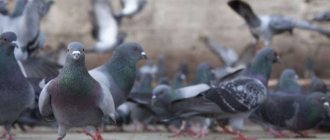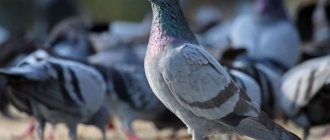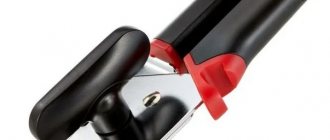Home » Articles about pigeons » How to scare away pigeons
These unpretentious birds are often called “flying rats.” They coexist with humans - they have mastered the urban environment, causing damage to farms and grain elevators. Knowing how to scare away pigeons will help you avoid many problems. Coping with an invasion is not so easy. To solve the problem, chemical repellent gels, mesh, spikes and other means are used.
Neighborhood Danger
The presence of pigeons is revealed by droppings - it covers the eaves on the facades of the building, the floor in the attic and balconies, and the roof of the building. In addition to the fact that aesthetics suffer, this creates other problems. Ammonia present in excrement corrodes surfaces. On farms, bird droppings contaminate feed and drinking water. Its dried particles are spread by the wind, and infections are spread along with them. The most dangerous of them:
- ornithosis is an acute infectious disease accompanied by lung damage, intoxication, and disruption of the central nervous system;
- encephalitis - this disease leads to inflammation of the brain; epilepsy can become a complication;
- salmonellosis - the disease leads to serious dehydration and intoxication, can cause kidney failure, it is especially dangerous for children and the elderly;
- histoplasmosis - the fungus Histoplasma capsulatum mainly affects the lungs, causes pneumonia, and in severe cases it spreads throughout the body.
The list below does not include all the diseases that pigeons can transmit to humans. This makes you seriously think about the question of how to keep them away from the windowsill and balcony.
Simple measures
You should think about preventing unwanted proximity. Simple measures will help with this:
- in the attic it is worth sealing the cracks with mineral wool or other material, protecting the ventilation openings with grilles or special elements blocking access;
- You need to remove garbage from the balcony and garden plot - uninvited guests can build nests there;
- You cannot feed birds, leave food prepared for domestic animals open, it is advisable to complicate access to water;
- if possible, you need to take care of glazing the balcony or loggia.
Preventive measures
In order not to encounter a problem the first and subsequent times, for preventive purposes, follow the recommendations:
- Always keep your balcony clean. Try to clean your balcony at least occasionally, throwing out trash. Place things that you don't think need to be thrown away in a bag.
- Do not store food on the loggia. Any food will attract a hungry pigeon.
- Sometimes it happens that pigeons are brave, but on the neighbor’s balcony people feed the birds. Talk to your neighbors and ask them to feed the birds elsewhere.
- Get a cat. Predatory instincts will force the cat to constantly hunt for pigeons, which will scare away uninvited guests.
Here are more or less humane methods of controlling feathered pests. First of all, use them without harming the birds. Use more cruel methods - poisoning, physical violence - only in very difficult situations.
How can you scare away from the balcony?
In cities, open balconies and loggias become a favorite place for pigeons. There they shelter from bad weather, keep warm in cold winters, and find food. Before choosing a solution, it is worth assessing the scale of the problem. If birds land on the railing, it is enough to make it awkward for them to land. Special spikes made of metal or plastic are suitable for this. The sharp teeth have different heights - usually 2-3 cm is enough. They are most often secured with glue. Place it so that the pigeons do not have any free space to land - this will scare them away from the balcony. Thanks to the flexible base, the spikes can be attached to railings of any configuration.
If you choose the interior space of a balcony or loggia, then you have to decide how to deal with the problem taking into account financial capabilities. The most expensive, but at the same time the most practical option is glazing. In addition to protection from birds, frames provide other benefits - the room becomes warmer and quieter, and less dust penetrates from the street.
If such expenses are not planned, then the situation will be saved by a grid blocking access to the site. It can be made of plastic, stainless wire, nylon. The color, size of the cells, their shape and orientation (horizontal, vertical) are different, which allows you to choose the most aesthetic protection option. The materials used are resistant to ultraviolet radiation, precipitation, and temperature changes. They have a long service life (on average 10 years).
If necessary, “windows” (slits with Velcro) can be provided in the mesh.
This design serves as effective protection without interfering with free air exchange. The loggia or balcony of the apartment is used as before. The owner of the premises no longer has to think about how to repel pigeons. The problem is solved forever with minimal costs.
Other methods:
- fishing line stretched at a height of 50 mm from the outer window sill or railing (several strips will be required);
- old CDs - they reflect the rays of the sun, blinding the eyes;
- foil or silver paint (perform the same functions);
- brightly colored balloons (under the influence of the wind they move and scare away birds).
Comparison table of methods and repellers
| Method/product | How, when and where to use it best | Benefits of exposure | Minuses |
| Grids | For the protection of attic windows, ventilation hatches, cornices, window sills, flower beds and beds | Affordable, durable, versatile | Not very aesthetically pleasing |
| Spikes | On the eaves of houses and city fences | Prevents pests from landing on surfaces | Not very aesthetically pleasing. Needs to be cleaned periodically. |
| Wire | On the eaves of houses, railings, fences, roofs, facades | Effectively repels birds. More appropriate and aesthetically pleasing than spikes | Periodically you need to check the integrity of the tension wire |
| Electrical Bird Control Systems | To protect any areas and surfaces attacked by pigeons | Durable: service life -8 years. Does not kill, but only scares away birds | Expensive. More suitable for deserted places: roofs, industrial sites. |
| Chemical repellents: gels, sprays, naphthalene | Various surfaces are processed: cornices, roofs, railings, lawns, monuments, etc. | Causes a persistent reflex that forces you to avoid treated areas in the future | Some compounds are toxic and require proper use according to instructions. |
How to keep him away from the windowsill?
If the loggia is glazed, this does not provide a complete guarantee that the pigeons will not be annoyed - the outer window sill (drainage) becomes a convenient platform for them. You can keep them away from the window sill from the outside of the window by changing its angle to 45 degrees using special pads. This makes it difficult for birds to land. If the drainage system is already installed, then you can scare away pigeons from the window by attaching spikes to it, as is the case with the balcony railings.
Other methods:
- pasting the window sill with food foil;
- lubricating the surface with oil or Vaseline.
Repelling birds in cities and villages
In urban and rural areas, deterrence methods differ depending on specific security measures, the scale of the problem and the property being protected. Usually the species composition differs, which is determined by the bird’s lifestyle, composition and availability of food supply for it.
Sparrows, pigeons and crows are most often found in the city, and seagulls are also found in coastal areas. Crows, seagulls and pigeons rake up the garbage and scatter it. Sparrows can cause much less harm, but they can sneak into warehouses and stores and spoil food. All of these species leave droppings on window sills, under the eaves of houses, trees and various structures. In disadvantaged countries they spread diseases.
In the city, it is convenient to use methods of limited action, such as gel or water repeller that works over a small radius, as well as spikes.
Outside the city, the arsenal of fighting methods is expanding. Deterrent sprays are sprayed on fruit trees or large fields. More powerful water repellers and scarecrows are placed near the house, and metal or plastic reflective tapes are hung.
How to scare pigeons off your roof?
To protect the roof from “flying rats,” you can use spikes, but due to the large area, this is unprofitable. Since it is impossible to cover the entire roof, it will not be difficult for birds to find a place to land. This makes it advisable to use a laser repeller. It creates a cacophony of light in space - when it hits the eyes, the beam disorients. You can choose the method of operation - with or without beam rotation. The rotation speed is adjustable. Mounting options: on a tripod or on a bracket. The device operates silently and consumes little electricity.
You can also:
- install weather vanes;
- cover the roof space with a mesh at a height of half a meter;
- install an electric repeller (power supply with cable) - upon contact, the bird receives a non-life-threatening electric shock;
- sprinkle food mixed with sawdust, plenty of salt or a concentrated solution of potassium permanganate.
Sharp noise, bright objects - festive measures to discourage birds
To drive away pigeons landing on a balcony or roof, you can take the initiative into your own hands rather than setting traps. For example, the explosion of a firecracker or New Year's cracker will permanently discourage birds from approaching the place where they were frightened. But this is a short-term measure and only against a certain flock or several individuals. After some time, other, unafraid birds may appear.
It should be borne in mind that such measures are appropriate in a private house with a large territory, where noise will not disturb the neighbors. In an apartment, this method can lead to complaints. A quieter way would be balloons with eyes drawn on them. Swinging and spinning in the wind, they will create confusion in a flock of pigeons and help scare away the birds for a long time.
How to scare away from the site?
If the plot is large and poultry is raised on the farm, then pigeons pose a serious danger. They eat food and spread infectious and parasitic diseases. The enclosure can be protected by placing a net on top. It is unlikely that you will be able to scare away pigeons from the site forever, but the domestic stock will be protected. If we are talking about protecting the entire area, then you will have to purchase a repeller.
Sound vibrations that scare away pigeons are produced by a bioacoustic installation. It broadcasts sounds associated with predators or causing acoustic stress. Settings:
- contain several dozen sounds;
- able to operate on battery power for a long time;
- are programmed taking into account the tasks being solved (the volume, range of sounds, and the interval between them are adjusted).
The case is protected from precipitation, dust and temperature changes.
Additional options are available to protect the device from theft and damage. Such installations are used in suburban areas, on farms, elevators, gardens, fisheries and other farms. When used on farms, farm animals become accustomed to the sounds produced within a few days - installation of the device does not affect productivity. You can also use an ultrasonic or laser repeller.
If you have to fight with other birds, it is advisable to place a scarecrow on the site. Currently, you can choose a complex model that combines a “predatory” appearance (owl, eagle, falcon), sound, light, movement (the scarecrow flaps its wings, screams, its eyes glow).
Another way to fight is water. In case of a massive invasion of birds, they are watered with a hose. For constant repelling, sprayers are used - special devices with a motion sensor are especially effective.
How to remove pigeons from the attic?
To prevent birds from entering the attic, it is worth sealing the cracks, glazing the windows, if any, and protecting the ventilation holes with mesh. If they do settle in, you can use natural or chemical scents. Knowing which ones are best at repelling pigeons can quickly solve the problem. The birds do not die. Strong aromas are unpleasant for uninvited guests - you can use spices (cloves, mustard, cinnamon, paprika, cayenne or allspice). As for chemical agents, it is advisable to use ordinary naphthalene in powder form. Specific food - millet with pepper - will also force you to leave the attic.
Strong smells can help too
All animals have a fairly acute sense of smell. And they don’t like it when pungent odors interrupt information about the environment for a long time or when caustic substances clog their nostrils. Birds are no exception. With the help of ordinary mothballs laid out on the balcony, it is quite easy to wean pigeons from stopping there to rest or making nests. But it should be remembered that this substance is quickly exhaled in the open air.
Another option is to pour hot spices into the feeders mixed with grain. They will not cause long-term damage to the pigeons, but they will provide a few unpleasant hours. In such a place where unpleasant sensations await them, birds will not land for a long time. The disadvantage of this method is that the powdered spices are quickly blown away by the wind, and the need to replenish their supply, which will lead to additional costs.
Poison as a means of control is the worst option. Firstly, this is not humane, and secondly, the bird can die in a hard-to-reach place, and the smell of decomposition will poison the lives of the owners of the house and the people around them. As a last resort, you should use caustic gels mixed with feed, which, after tasting, will cause the birds to disgust the place where they were laid out.
Chemical repellents
When deciding how to keep pigeons away from your home, you can opt for chemical repellents. It is advisable to use relatively safe means:
- sticky substances - they glue paws, glue feathers, which makes birds refuse to visit “dangerous” places;
- non-toxic repellents based on strong-smelling substances (essential oils, menthol, capsaicin) with an unpleasant taste - they do not lead to poisoning (preparations with such properties can be found in the assortment of Pestman or other manufacturers).
Such means have their drawbacks. Sticky substances accumulate dirt over time, lose effectiveness, and spoil the appearance of eaves, window sills, and ebbs. If a small bird lands on the trap, it may subsequently die due to feathers sticking together and the inability to fly normally. It is difficult to clean surfaces from frozen substances. Strong-smelling substances should not be used in closed spaces if there are people present. In open areas they lose effectiveness over time.
Ways to fight
Residents of the upper floors know that the constant noise made by their feathered neighbors can torment even the most patient person. When small birds colonize an attic space, a large amount of droppings, feathers, dust and debris accumulate, making it almost impossible to enter there.
In addition, the danger of contracting a dangerous disease exists even when inhaling dust particles that contain microparticles of pigeon droppings. Bird control measures are divided into the following types:
- Warning. These measures involve a set of actions aimed at making the roof structure unattractive to birds. To do this, when designing a structure, it is necessary to avoid protrusions or niches that could become a convenient place for nesting.
- Repellent. These measures are aimed at creating conditions that will scare birds away from human homes. To make the roof of a house unattractive to birds, sound or light effects and anti-landing devices are used that make it difficult to land on the roof slopes.
- Fighter. These measures include the destruction of birds and their nests by physical or chemical methods. They are the most inhumane and cruel method of getting rid of birds, so they are used extremely rarely.
Important! When deciding how to get rid of pigeons on the roof of a balcony, you need to familiarize yourself with the Law “On Environmental Protection”, which states that the destruction of birds and their nests in their natural habitat is an administrative offense. Although pigeons and sparrows are not listed in the Red Book, they are also part of our ecosystem, so it is necessary to make their eviction from the roof as humane as possible











